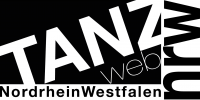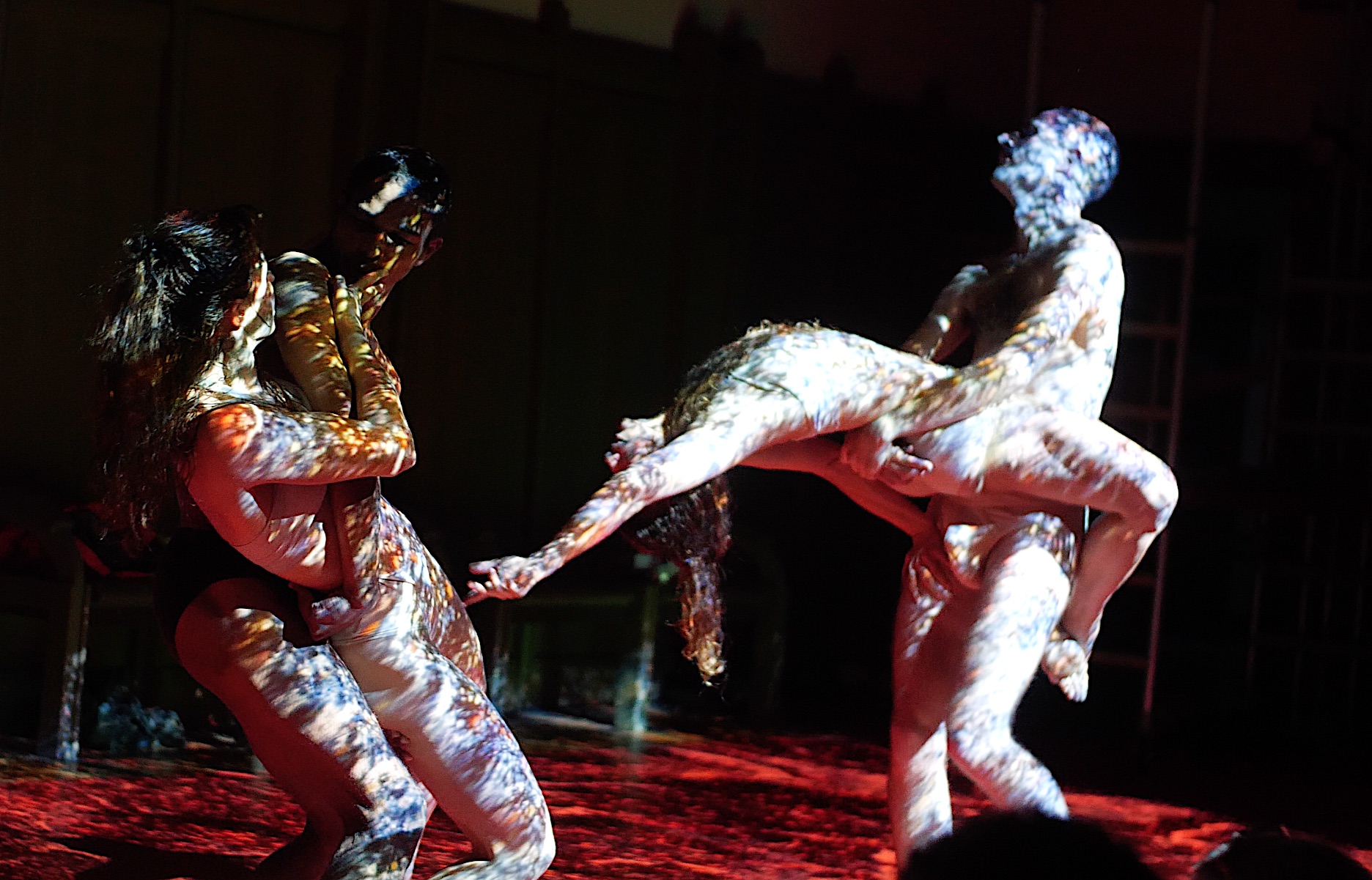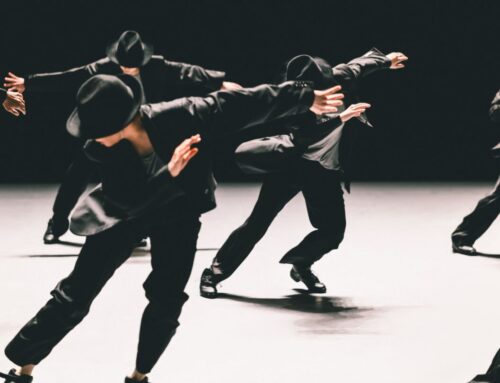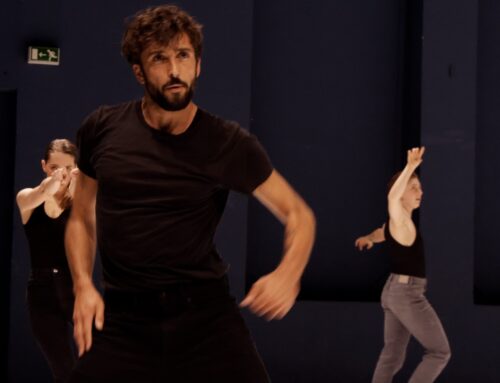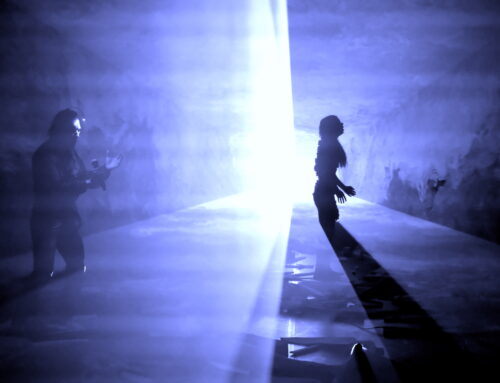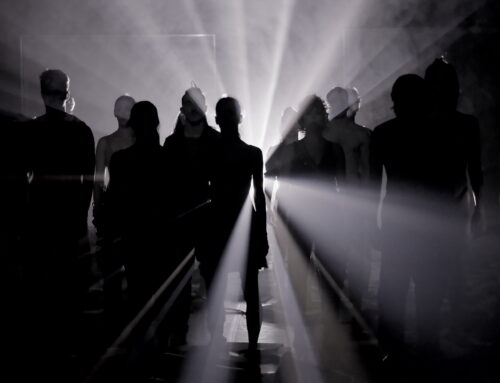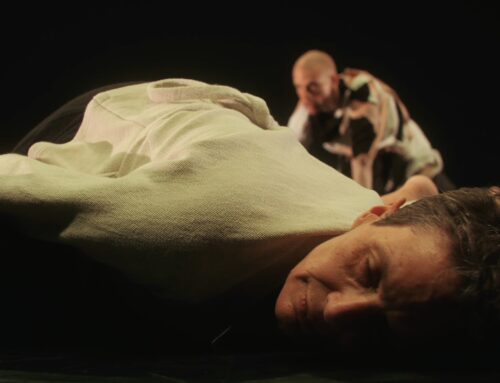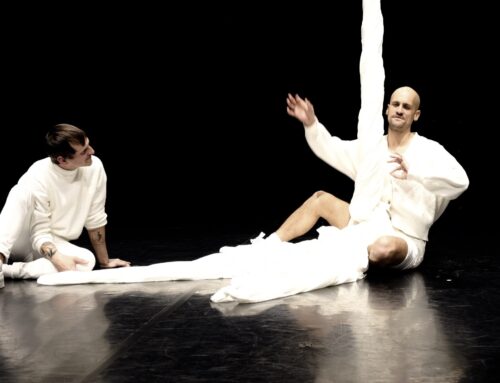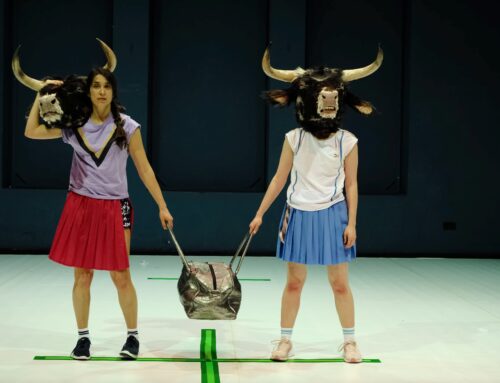Sea of blood and brightness of hope
The dance theatre company „Bodytalk“ in Münster presents the „Westphalian Peace Ballet“. Peace is kept within limits. The ballet too.
By: Harff-Peter Schönherr
Peace. This word is often heard in Münster these days. Inflationary often. The city celebrates the 375th anniversary of the Peace of Westphalia in 2023, and there is no shortage of events commemorating the major diplomatic event that ended the Thirty Years‘ War in 1648.
One of them, one of the most important, the „Westphalian Peace Ballet“, takes place at the foot of the Lamberti Church. If you look up to its tower, on the south side, you will see horrifying evidence of another war that wrote Münster’s city history: Here hang to this day the three cages in which, a century before 1648, the remains of the Anabaptist leaders Jan van Leiden, Bernd Krechting and Bernd Knipperdolling, tortured to death, were displayed.
The place where the Münster dance theatre company „Bodytalk“ presents its „Peace Ballet“, originally the „Krameramtshaus“ of the merchants‘ guild, is a telling choice: it was one of the venues for the negotiations that, at the same time as the Thirty Years‘ War, brought the Eighty Years‘ War between the Netherlands and Spain to an end. If you follow the dancers into their dressing room, you enter a magnificent fireside room at whose almost room-filling table you can well imagine the peace negotiators of that time. Today, as the „House of the Netherlands“ science and culture centre, it is a reminder of the time when people came together here to let the guns fall silent after a generation of devastation in half of Europe.
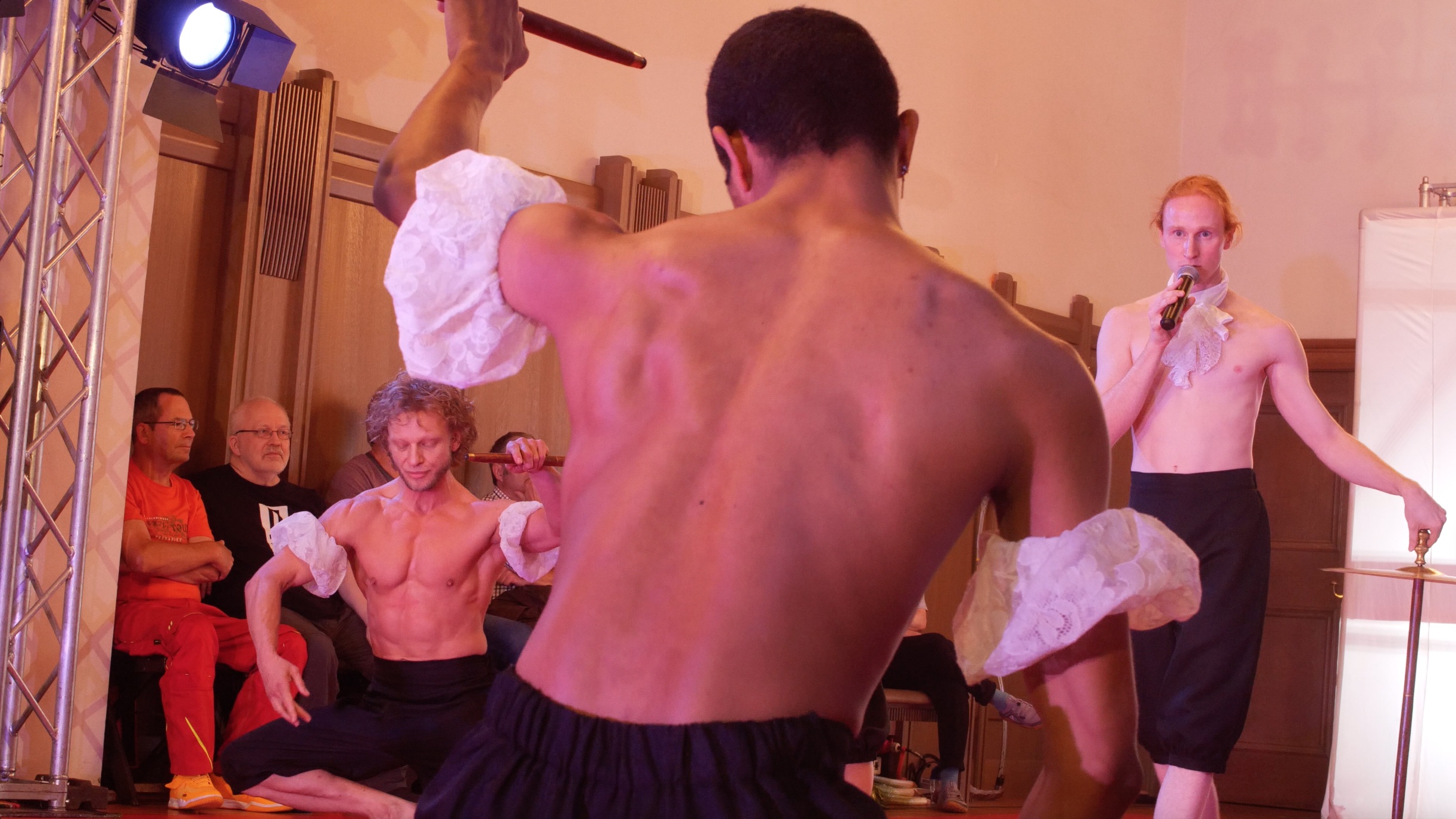
Westfaelisches-Friedensballett_bodytalk©TANZweb.org_Klaus-Dilger
As historical as the setting is, as modern is the stage action. As dry as its title sounds, as a reference to the „Ballet de la Paix“ that was supposedly performed here in 1645, it touches us in a lively way. Here, peace is not just an antithesis to war. And anyone who reads the wonderfully offbeat, comedically serious programme leaflet before the start, which calls out witty sentences like „Imagine it’s peace and no one notices!“, suspects that it will be worth being a decoder for the next 80 minutes.
That’s still easy with „Wally“ and „Tillenstein“, the name-distorted general celebrities from the great battle to which millions of people fell victim. But the „Mehr is dwang gnog“, framed by pale gold laurel and equally pale gold oak leaves, only becomes clear to those who enter the hall. There it can be seen on the wall, as a fresco, as a reference to the honourable merchants. However, it is written in a decisively different way: „Ehr is dwang gnog“. Those who are capable of decoding read it as: „Honour is compulsion enough“. Which means as much as: Those who are noble need no set of rules, no curtailment of their freedom by others, in order to serve the good, because they force themselves to do so.

Westfaelisches-Friedensballett_bodytalk©TANZweb.org_Klaus-Dilger
Noble? Good? Man, we learn from „Bodytalk“, is not. At least not most of the time. Or not for long. So peace has a hard time. And the alienating „more“ that is enough of a constraint in the production choreographed and directed by Yoshiko Waki and Rolf Baumgart? Perhaps it subliminally shakes its head at the inflation of peace that the Münster city anniversary allows itself in the name of 1648. One doesn’t know, and that offends the decoder’s honour. But the rest of the riddles posed by the „Peace Ballet“ can be solved.
The bloody battlefield that awaits us holds the deepest abysses. People massacre each other like at the Red Wedding in Game of Thrones, and yet it is not extinguished, the hope for closeness, for gentleness, for mutual understanding. Everything becomes a weapon, suffering and death are omnipresent, and yet it lives on, the certainty that there is an opposite world, a world of brightness. A nightmare of violence thunders at us, a whirlpool of destruction drags us down into darkness. And yet the certainty remains that there is beauty, that the good in us is not powerless.

Westfaelisches-Friedensballett_bodytalk©TANZweb.org_Klaus-Dilger
The ballet begins with ballet, very classically, very cultivated, in the rehearsal hall, as for the „Ballet de la Paix“. But the break comes quickly, almost atavistically, and that is good. The dance language becomes contemporary: bodies tumble, slide, climb, convulse, chase, twitch, freeze. Fights erupt, intensify, find their victims. Orgiastic excesses are unleashed, and those who can’t handle nudity, sex or torture poses have a hard time. All of this is dense with atmosphere, is dizzying and breathless, is fine-nerved and multi-layered, is a single, great symbol: Conditio humana.
„Bodytalk“ challenges with deafening brutal rap. Basses drive into the stomach. Cymbals blare. Sticks stomp. Metal clangs. Sirens wail. In between, virtuoso art song, meditative music as if from a harp. All this is live. The orchestra: Jan Paul Werge. On flute, laptop, drums and microphone. Sometimes he walks across the stage on high heels. Sometimes he wears fruit on his head, like in a still life by Acrimboldo.
The light colours are suggestive. The projections on the floor, walls and ceiling envelop us in doomsday scenarios, in LSD escapism. The high acting potential of the ensemble allows their gazes to bore into ours. Everything is just right: the balance of control and risk, the facial expressions and gestures, the athleticism, the sense of space, the timing, the immersion in the role.
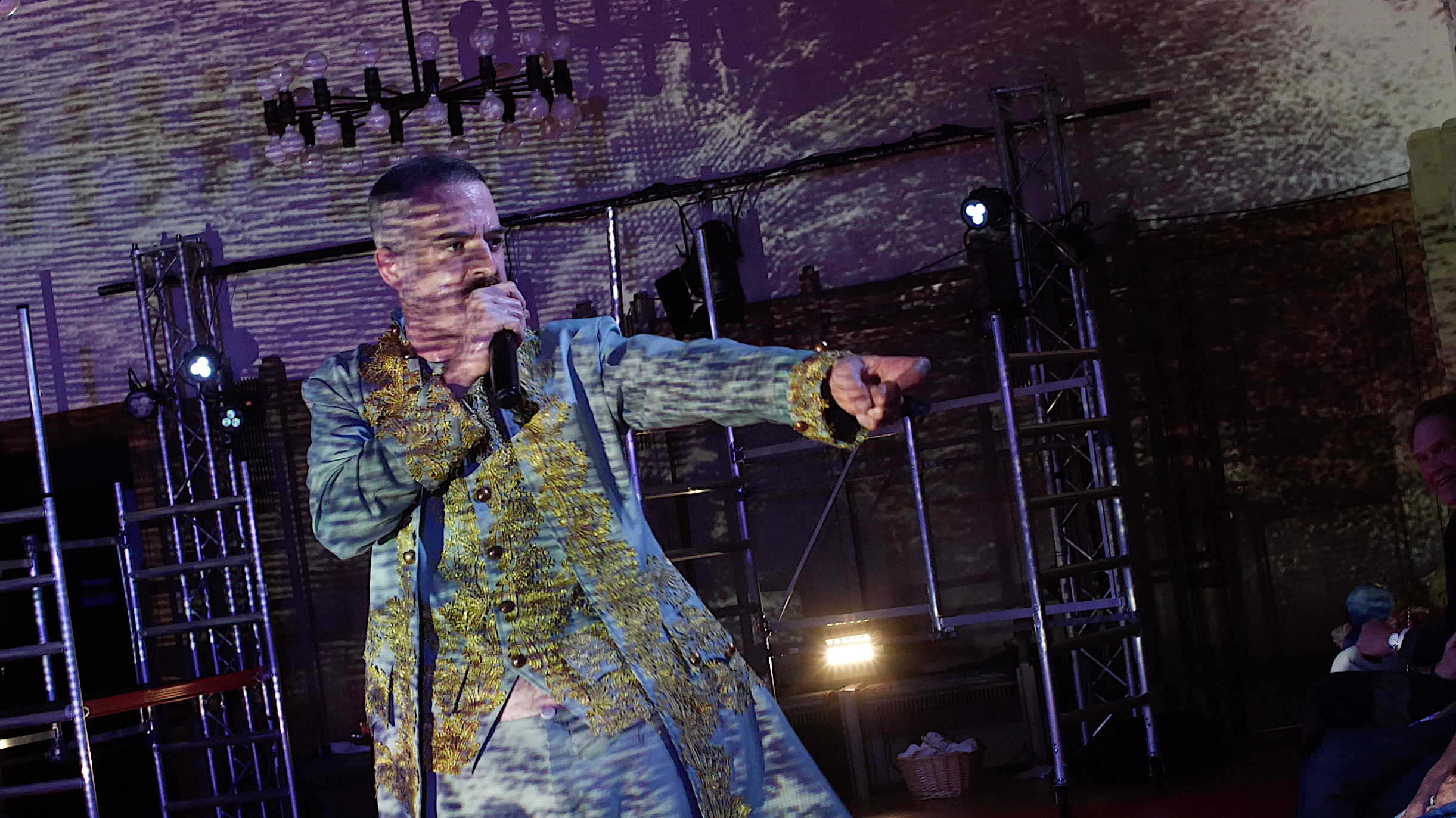
Westfälisches Friedensballett_bodytalk©TANZweb.org_Klaus Dilger
In parts, the „Peace Ballet“ seems like a happening, and anyone who doesn’t like the audience being asked to participate is a little out of place for a quarter of an hour. But the „experiment“, which, according to the promise, „almost doesn’t hurt at all“ (which is true), results in a powerful, eye-opening image. Many of the audience members stand shortly afterwards in the stage space, which is now finally the world stage, as living memorials to deadly wars of the present: Somalia, Kurdistan, Syria, Mali, Ukraine, Palestine.
Afterwards, the performers draw the audience into conversation. They reveal, very personally, turning points and anchor points in their lives, seek encouragement, offer their bodies to testify to what they have heard, to complete it, to comment on it, as a drawing, as a text. Dancer Dominik Więcek talks about the „system“ of the dance world, against which he has given up fighting. Dancer Paweł Malicki paints a house on his chest, invites to paint other houses to it, with paths from one to the other.

Westfaelisches-Friedensballett_bodytalk©TANZweb.org_Klaus-Dilger
The openness is great, as is the sensitivity. Laughter, curiosity, shyness, amazement. Suddenly there is brightness in the room, a sigh of relief. But that doesn’t last long: the scenes that follow are like something out of Dante’s Inferno. Seas of flame open up before us. Skulls distort on tortured bodies.
„Bodytalk“ aims at a total work of art. The audience helps to tape one of the performers with parcel tape. A count’s envoy tells crude stories. It’s about Rosa von Praunheim’s army of lovers. The audience is entertained. Some fight scenes are reminiscent of Mad Max. Sometimes the floor is full of leek shreds, because vegetables can also become weapons.
Is man capable of peace? In 1648 he was. Only a few years later, war broke out again in Europe. If we learn to be different, it is through evenings like this.
3 to 6 August, House of the Netherlands, Münster
Venue: Haus der Niederlande (former Krameramtshaus) Alter Steinweg 6-7, 48143 Münster Trigger warning: depiction of sexual violence – Not suitable for children and young people under 14 years of age.
Based on an idea by Ludger Schnieder by Yoshiko Waki and Rolf Baumgart by and with Anna Katalin Nemeth, Dominik Więcek, Jost op den Winkel, Justin Brown, Luana Rossetti, Paweł Malicki, René Haustein feat. Haftbefehl Live music Jan Paul Werge Set design Marina Schutte Video Sven Stratmann Technical direction, lighting Timo von der Horst Production David Bäcker Supported by the Ministry of Culture and Science of the State of North Rhine-Westphalia, Cultural Office of the City of Münster, Kunststiftung NRW, Stiftung Bürger für Münster.

Westfaelisches-Friedensballett_bodytalk©TANZweb.org_Klaus-Dilger
